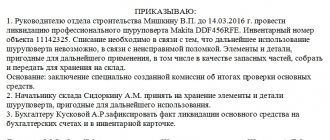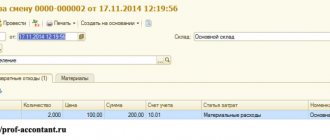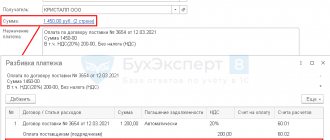Let's consider an operation that, based on inventory results, most trade organizations face the need to carry out. The focus is on writing off goods that have become unusable: when, why and in what order to carry it out, what kind of documents to draw up, etc. We will try to analyze in detail all the key points so that you clearly understand how to include the cost of damaged items in the expense item of the enterprise (and remove it from circulation) in accordance with all the norms of current legislation.
Let us immediately note that the nuances of performing this procedure are clearly regulated and regulated by a number of Federal Laws and the Civil Code of the Russian Federation, up to the destruction or disposal of products in the event of their non-return to the supplier (both without the presence of third parties and with the involvement of supervisory government agencies). But, before considering it, we suggest you understand the definitions.
What is considered a product in accounting?
This is an object that belongs to the category of inventories, but is purchased specifically for subsequent resale, and not for use. This distinguishes it from raw materials, materials or products manufactured for further use. It is understood that it must be profitable, that is, it must be sold at a higher price than purchased (which is not always possible in practice - due to various circumstances). When reflected on accounts, it is not so important what status its owner is in: it can be either a legal entity or an individual, an international concern or a private entrepreneur.
What is a product in taxation?
Regardless of the chosen mode (OSNO, UTII, STS), any inventory items, that is, property objects intended for subsequent sale, fall under this category. In this case, income also means the plus difference between purchase and resale prices.
But, from the point of view of collecting mandatory customs duties, the definition is different: in accordance with it, the term in question means any assets (including real estate) that can be the subject of a transaction, not only things or foreign currency, but also shares, and even electricity or traveler's checks.
Reasons for writing off goods from the warehouse
The most common is a sale that is carried out on a paid basis to a counterparty under a previously concluded agreement. Although there are other implementation options, including:
- with the involvement of an intermediary;
- with access to the national (in our case, the domestic Russian) market;
- with export and payment in rubles (or their dollar or euro equivalent).
The list of other common reasons:
- withdrawal to pay for ownership (full or its share) in the authorized capital of any enterprise;
- exchange for other items;
- disposal for use in the course of its production activities;
- theft, damage, shortage;
- gratuitous transfer;
- force majeure circumstances.
Accounting
The actual cost of written off expired goods is reflected in the debit of account 91 subaccount “Other expenses” in correspondence with the accounts of these assets.
If expired products cannot be disposed of, they must be destroyed. In this case, their cost is reflected in account 94 “Shortages and losses from damage to valuables.” Example 1
Khlebny Dar LLC identified expired bakery products with a purchase price of 6,000 rubles.
This food product had no obvious signs of poor quality. Therefore, part of it costs 100 rubles. the company sent it for examination, which cost 590 rubles. (including VAT - 90 rubles). According to its results, the company is prohibited from recycling the goods, so it destroyed them. The cost of liquidation of goods amounted to 1800 rubles. The accountant of Khlebny Dar LLC made the following entries: Debit 41 subaccount “Expired goods” Credit 41 “Goods for sale”
- 6000 rubles.
— expired goods are taken into account; Debit 91 subaccount “Other expenses” Credit 41 subaccount “Expired goods”
- 100 rubles.
— goods were transferred for examination; Debit 91 subaccount “Other expenses” Credit 76
- 500 rub.
— expenses for conducting the examination are reflected; Debit 19 Credit 76
- 90 rub.
— reflects the amount of VAT on examination services; Debit 68 subaccount “Calculations with the budget for VAT” Credit 19
- 90 rubles.
- the amount of VAT is presented for deduction. Debit 94 Credit 41 subaccount “Expired goods”
- 5900 rubles.
(6000 – 100) — goods subject to destruction are written off; Debit 91 subaccount “Other expenses” Credit 94
- 5900 rub.
— losses from damage to goods are taken into account; Debit 91 subaccount “Other expenses” Credit 76
- 1800 rub.
— reflects the cost of work on the destruction of goods. Example 2
OJSC Bakery Bakery identified expired cereal with a purchase price of 22,000 rubles.
This food product had no obvious signs of poor quality. Therefore, part of it costs 100 rubles. the company sent it for examination, which cost 590 rubles. (including VAT - 90 rubles). Based on its results, the company was allowed to dispose of the goods, so it sold them to a livestock organization for animal feed. Revenue from the sale of goods amounted to RUB 21,240. (including VAT - 3240 rubles). The company's accountant made the following entries: Debit 41 subaccount “Expired Goods” Credit 41 subaccount “Goods in Warehouses”
- 22,000 rubles.
— expired goods are taken into account; Debit 91 subaccount “Other expenses” Credit 41 subaccount “Expired goods”
- 100 rubles.
— goods were transferred for examination; Debit 91 subaccount “Other expenses” Credit 76
- 500 rub.
— expenses for conducting the examination are reflected; Debit 19 Credit 76
- 90 rub.
— reflects the amount of VAT on examination services; Debit 68 subaccount “Calculations with the budget for VAT” Credit 19
- 90 rubles.
- the amount of VAT is presented for deduction. Debit 62 Credit 90 subaccount “Revenue”
– 21,240 rubles.
— revenue from the sale of expired goods is reflected; Debit 90 subaccount “VAT” Credit 68 subaccount “Calculations with the budget for VAT”
- 3240 rubles.
— VAT is charged on sales; Debit 90 subaccount “Cost of sales” CREDIT 41 subaccount “Expired goods”
- 21,900 rubles. (22,000 – 100) — the cost of goods with expired expiration dates is written off.
Regulation by law and features of writing off goods from the warehouse
An inventory is carried out, and as a result, expired and damaged items are identified, as well as those that do not have an expiration date on the label. All of them must be withdrawn from circulation - in accordance with the standards given in Federal Law 2003-1 (effective from February 7, 1992) and Articles 469, 470, 472 of the Civil Code of the Russian Federation.
In accordance with them, the seller’s responsibilities include offering the target audience only items of appropriate quality, that is, suitable for use. It is forbidden to sell things that do not satisfy this condition, but the period of their relevance is set so that by the time it expires people will have time to use the products in question.
In addition, the Law “On the Protection of Consumer Rights” defines a number of products on the labeling of which the expiration date should always be indicated, and these are:
- medicines;
- cosmetics;
- household chemicals;
- food products.
If the required numbers are not indicated on the packaging or the sales time has expired, the items must either be returned to the supplier or disposed of/destroyed. The latter can be done without the involvement of third parties if the origin of the products cannot be accurately determined. In any other situations, it is necessary to contact the relevant supervisory authorities - commodity, sanitary, veterinary, depending on the nature of the items - so that their competent representatives give their expert assessment of the condition of the objects.
Do you want to implement Warehouse 15? Get all the necessary information from a specialist.
Thank you!
Thank you, your application has been accepted!
Preparation of primary accounting reports for expired goods
The write-off procedure is determined by the company's management. Internal company regulations should establish:
- the procedure for identifying and withdrawing from sale expired goods;
- the procedure for sending them for recycling or destruction;
- the procedure for documenting the entire process.
As a general rule, the identification of goods unfit for sale is activated. The act indicates: names of goods (according to accounting nomenclature), quantity, location at the time of expiration. A separate section of the act must indicate the further fate of expired goods - disposal, destruction or return to the supplier.
The unified album of primary forms (approved by Goskomstat on December 25, 1998) for such purposes proposes the TORG-15 form for recording the fact of damage and TORG-16 for recording withdrawal from circulation and the decision on destruction or disposal.
Look for forms and samples of filling out forms for write-off in the articles:
- “Unified form No. TORG-15 - form and sample”;
- “Unified form No. TORG-16 - form and sample”.
In this case, the business entity is allowed to develop forms for writing off inventory items independently, taking into account the requirements for the preparation of primary documents, which are specified in Art. 9 of the Law “On Accounting” dated December 6, 2011 No. 402-FZ.
The transfer of goods for disposal to a specialized company is formalized in the same way as sales (invoice, UPD, etc.).
The procedure for writing off goods
Conducted in accordance with rules No. 49, in force since June 13, 1995. During the inventory, damaged products are not included in the inventory - they are included in a special act drawn up according to forms TORG-15 and 16. Moreover, the first records the very fact that the item has lost its consumer properties, while the second documents its withdrawal from circulation and all subsequent operations with it ( recycling and the like). The need for destruction must be confirmed by a separate order - the commission’s conclusion in this situation is not enough.
If defects are identified, financially responsible persons are required to provide written explanations. Such actions are needed to establish the reason why the goods should be written off, and this is, most often:
- loss of consumer properties caused by expiration;
- damage caused by negligence;
- force majeure circumstances.
A series of letters from the Ministry of Finance - dated May 26, 2021, August 23, 2021 and others - confirm that disposal costs can be taken into account along with a reduction in the tax base, which is very convenient. Similarly, it is permissible to indicate the loss within the normal range. If things have lost their characteristics due to improper storage, the perpetrators are obliged to compensate their cost in accordance with Chapter 39 of the Labor Code of the Russian Federation. The loss must be reflected first under Article 265 of the Tax Code of the Russian Federation, that is, in the category of non-operating expenses, and then under Article 250, that is, in income.
If objects are damaged due to a natural disaster, their cost can actually be calculated as expenses under Art. 265-2-6, along with the fact that those involved in the damage have not been identified. This situation must be confirmed by a certificate from the Federal Tax Service indicating the closure of the criminal case.
Tax accounting: calculation of income tax
To calculate income tax, the procedure for writing off goods depends, again, on the situation in which the product was damaged. If the goods have expired, then their price is fully taken into account in other expenses (subclause 49, clause 1, article 264 of the Tax Code of the Russian Federation, Letter of the Ministry of Finance dated December 24, 2014 No. 03-03-06/1/66948, dated December 20 2012 No. 03-03-06/1/711). If the goods are damaged due to the fault of the employee, then their cost is included in non-operating expenses (subclause 8, clause 7, Article 272 of the Tax Code of the Russian Federation): or on the date when the employee acknowledged the amount of damage (for example, on the date of concluding an agreement on voluntary compensation for damage), or on the date when the court decision to recover the amount of damage from the employee came into force. At the same time, the income must take into account the amount of damage found guilty or awarded by the court (subparagraph 4, paragraph 4, article 271 of the Tax Code of the Russian Federation).
If goods are damaged due to an emergency, then their cost is included in non-operating expenses on the date of drawing up a document from the competent authority confirming that the damage was caused by an emergency (natural disaster, fire, accident). For example, in the event of a fire, such papers will be a certificate from the Ministry of Emergency Situations, a report on the fire and a protocol for examining the scene of the incident (Letters of the Ministry of Finance dated December 29, 2015 No. 03-03-06/1/77005, Federal Tax Service for Moscow dated June 25, 2009. No. 16-15/065190). If the goods were damaged due to natural reasons, then their cost is taken into account in material costs within the limits of natural loss rates (Letters of the Ministry of Finance dated July 6, 2015 No. 03-03-06/1/38849, dated May 23, 2014 No. 03 -03-РЗ/24762).
VAT previously accepted for deduction on damaged property does not need to be restored, since such a basis for restoring the tax is absent in paragraph 3 of Article 170 of the Tax Code of the Russian Federation. A similar opinion is expressed by regulatory authorities. In their explanations, they refer to court decisions that have always supported taxpayers who did not restore VAT (Letters of the Federal Tax Service dated June 17, 2015 No. GD-4-3 / [email protected] , dated May 21, 2015 No. GD-4-3 / [email protected] ).
Read also “VAT Restoration”
EXAMPLE.
DISPOSAL OF DAMAGED GOODS IN THE ABSENCE OF GUILTY PERSONS The store transfers a unit of goods to the sales area for display display.
The product was purchased at a price of RUB 3,540. (including VAT 540 rub.). After some time, the goods are considered completely damaged and written off. There are no employees at fault. In the company's accounting, transactions should be reflected as follows. When purchasing goods: Debit 41 Credit 60
- 3000 rub.
– goods have been received (3540 – 540) (supplier’s shipping documents, goods acceptance certificate); Debit 19 Credit 60
- 540 rub.
– reflects the amount of VAT presented (invoice); Debit 68/VAT Credit 19
- 540 rub.
– the submitted VAT (invoice) has been accepted for deduction; Debit 60 Credit 51
- 3540 rub.
– payment has been made to the supplier (bank account statement). If damaged goods are identified: Debit 94 Credit 41
- 3000 rub.
– the cost of damaged goods is written off (act of damage, damage, scrap goods and materials); Debit 44 Credit 94
- 3000 rub. – the amount of determined losses is included in the cost of sales (accounting statement).
How to write off goods that have become unusable: postings
The list of standard (most often used in practice) options includes the following:
- 94/41 – products are damaged and must be destroyed;
- 96, 44/94 – expenses are included in the loss reserve (pre-created) or attributed to an increase in sales costs (in this case they should not exceed natural loss);
- 41/42 reversal – the markup is reversed;
- 73/94, 91-2 – compensation is assigned to the perpetrators, and if they are not identified, then it goes to the item of associated expenses;
- 73/98 - if there is a difference in the accounting price and the amount of recovery from the responsible person, and 98/91-1 - if it can be included in other expenses;
- 90, 91-41 – recycling is carried out.
In situations where the volume of seized objects is greater than normal loss, code 94/68 is relevant.
Write-off of goods transferred free of charge
Since any transfer of goods is regarded by the Tax Code of the Russian Federation as a sale, then even in the case of a gratuitous transfer at the time of shipment, VAT is charged, and instead of a sales account, the account of other income and expenses is used - since there is no sale as such in this operation, and income from the disposal of inventory items is not reflected :
| Operations | D/t | K/t |
| The cost of transferred inventory items is written off | 91/2 | 41 |
| VAT charged | 91/3 | 68 |
| Transfer costs written off | 91/2 | 60, 71, 76 |
How to write off goods: examples
Let’s assume that 12 thousand rubles worth of products are allocated for sales, including VAT of 20%. After 30 calendar days, a special commission determined that these items were damaged. The act must reflect the price without VAT. No negligent attitude towards maintenance issues was revealed - experts found that there was a natural reason for the loss of consumer properties.
Then the entry will look like this:
Dt 94 Kt 91–10,000 rub;
Dt 44 Kt 94–10,000 rub.
Now let’s take the same initial conditions, but imagine that the items have lost their useful characteristics as a result of irresponsible storage. In order to correctly write off finished products that have become unusable in this case, the postings should be as follows:
Dt 94 Kt 41–10,000 rub;
Dt 73 Kt 94–10,000 rub;
Dt 50 Kt 73–10,000 rub.
They will show that the culprit, financially responsible on the basis of a previously concluded agreement, gave written consent to compensate for all damage. Moreover, they say that the amount paid by the person was deposited in cash to pay off the debt.
How to apply
There are several ways to fill out primary documents:
- data is entered into the fields provided for them in unified acts;
- information is entered more arbitrarily, in a independently developed form.
The first case is understandable, because everything in it is strictly standardized. But in order to write off goods and materials in a warehouse in the second and avoid financial risks, it is necessary that the form meets 3 requirements:
- has all the necessary details;
- certified by the signature of the head of the enterprise;
- agreed upon with the persons making the purchase.
Please note that the instructions assume that, depending on the reason for disposal of property, one or another primary documentation is filled out:
- payment certificate and invoice - when selling products on your own, donating them free of charge, exchanging material or using them in your own activities;
- a notification from the accounting department and an acceptance certificate - for the intermediary sale or issuance of valuable items in payment for a certain share of ownership;
- matching statement - in case of damage, shortage, theft, force majeure.
A typical (standard) form looks like this:
Write-off of expired goods: transactions
Inventory items identified by inventory that are overdue must be written off, since their sale is prohibited. Such illiquid assets are activated and, based on the results of a mandatory examination, are subject to either disposal (i.e., further processing and use is possible) or destruction (without the possibility of recycling). Decree of the Government of the Russian Federation No. 1263 of September 29, 1997 regulates the procedure for the examination of food products, as well as their destruction, and the execution of the corresponding act.
Postings for write-off transactions of similar goods are distinguished depending on whether the goods will be sent for processing or should be destroyed:
— when recycling D/t 90 (92) K/t 41;
— upon destruction of D/t K/t 41.
Accounting for written-off goods upon sale
In any case, this operation must be reflected in account 41, but the nature of the correspondence depends on the purpose of spending the property intended for sale.
The following options are possible:
Dt 62 Kt 90-1 – reflects the income received;
Dt 90-2 Kt 41 – the cost of property is recorded as expenses;
DT 51 (50) Kt 62 – the counterparty makes the payment;
with the registration of the sub-account “VAT Calculations”:
Dt 90-3 Kt 68 – calculation of tax payments.
Account 45 is used in situations where shipment to an intermediary is carried out after payment, then the most commonly used code is Dt 45 Kt 41, but Dt 45 Kt 68 is also possible.
Do you want to implement “Store 15”? Get all the necessary information from a specialist.
Thank you!
Thank you, your application has been accepted.
How to write off finished products that have become unusable
This process is an inventory stage, and therefore is implemented quite simply. All items that have lost their consumer characteristics must be documented and given to experts, while simultaneously filling out forms TORG-15 and 16. Thanks to the first of them, it will be possible to subsequently activate discounted items and successfully sell them. But keep in mind that this act should be drawn up in 3 copies, each of which must be signed by an authorized representative of the enterprise, a commission, a person bearing financial responsibility, an employee of the sanitary inspection authorities (not always). The first sample will remain in the company’s accounting department, the second - with the inspectors, the third - with the employee who must make the compensation (if his guilt is proven).
Let's see how to write off goods that have become unusable, the following entries are used:
Dt 94 Kt 41 - reflects the very fact of product disposal;
Dt 91-2 Kt 94 – indicates the extent of damage caused;
Dt 73 Kt 94 - shows what compensation the perpetrator will pay;
Dt 51 (50) Kt 73 - indicates receipt of funds.
Each of them is entered into documents based on the results of the inventory of inventories, supported by acts and statements. All decisions must also be confirmed by the signature of the manager. This will streamline paperwork and simplify all related procedures. Now let's take a look at special cases, which are also often encountered in practice.
How to write off goods from a warehouse - overdue for subsequent sale
Some products that have expired can still be sold, albeit at a reduced price, for recycling or use for other purposes. So, it is still permissible to make preserves, jams, and juices from spoiled fruits.
Naturally, purchase is possible only after checking by regulatory government agencies and obtaining all permits from their official representatives. Without special supporting papers, you can only destroy the objects (again, with the drawing up of an appropriate act), or negotiate a return with the supplier.
In a different way, damaged goods are written off in tax accounting if the subsequent use of these products is hazardous to health or the environment. Thus, washing powders and detergents, medicines or cosmetics can only be disposed of in a strictly appropriate manner. Therefore, many owners of household chemicals stores immediately enter into a recycling contract, either with specialized services or with the manufacturers of these goods and materials. But this is a point that the parties should agree on in advance, so that there are no problems with government control authorities, and things that have lost their consumer characteristics do not accumulate.
What to do with samples
Is it possible to write off goods for production if they were presented in small quantities? Yes, it is permissible to provide them free of charge to partners and contractors or even display them on display, but all these transactions still need to be reflected in reporting. It is also necessary to record the fact of the transaction with an invoice drawn up on form M-15, and draw up the accompanying primary documentation, including, among other things, an explanation of the reason for the transfer.
If samples are used for internal movement, for example, food products for tasting, they fit into TORG-13. This invoice is signed by the person who will be issuing samples during the event.
When deciding how to write off goods as materials, remember that even minimal quantities sent to third parties do not reduce income for tax purposes, because they are not included in any item of advertising expenses. Another thing is objects that are operated within the company: it is quite possible to include them in standardized expenses, even for the reporting period, but with one caveat: their total cost should not be more than 1% of the total sales revenue. Also keep in mind that VAT must also be paid on items transferred free of charge, and samples (in a standard situation) belong specifically to this category.
How to write off stolen goods to the guilty party
It is carried out based on the results of the inventory; Before carrying it out, it is also necessary to consider written explanatory notes from those employees who are financially responsible for the shortage.
After which the fact of arrears should be reflected in accounting - with an order containing the reason for the inspection and instructing to contact law enforcement agencies. He, along with the statement and the results of the examination, is sent to the police.
If the culprit can be found, he will need to repay the agreed amount; if not, criminal proceedings will be refused, and the theft will have to be presented as damages.
How to write off an item that is out of stock
It is necessary to conduct a global inventory - it will help not only to understand what is missing and in what volumes, but also to calculate the exact amount of debt. The results of the examinations performed should be included in documents compiled according to forms INV-3, 19 and 26.
Then, based on the available information, you need to determine the cause of the problem. And, based on it, make a decision:
- if the shortage fits within the framework of natural loss, it is attributed to the appropriate article and no one is fined;
- if the loss is more than normal, they look for the culprit and/or oblige the responsible person to compensate for the damage;
- if the attacker is not found, a criminal case is initiated, and if it is closed due to lack of evidence, all costs are borne by the company that owns the product.
To understand how to correctly write off an item from a warehouse that is out of stock, you also need to be able to accurately determine how much it costs. Items must be removed from the balance sheet at their actual price, adding to it the costs of delivery and subsequent storage, thus forming the final amount. When selling at retail, it is permissible to adhere to an independent policy and calculate the volume of losses, for example, 50 kg from the selling price of 1 kg.
And finally, there is software that makes accounting easier: it automatically sends requests, allows you to systematize all actions with the cash register, and prevents you from losing a single important operation.
Now that we have examined in detail the write-off of goods into production, postings and possible actions depending on the situation, contact Cleverence - we offer special software to simplify routine warehouse operations, including write-off of products in the warehouse. Number of impressions: 5141






